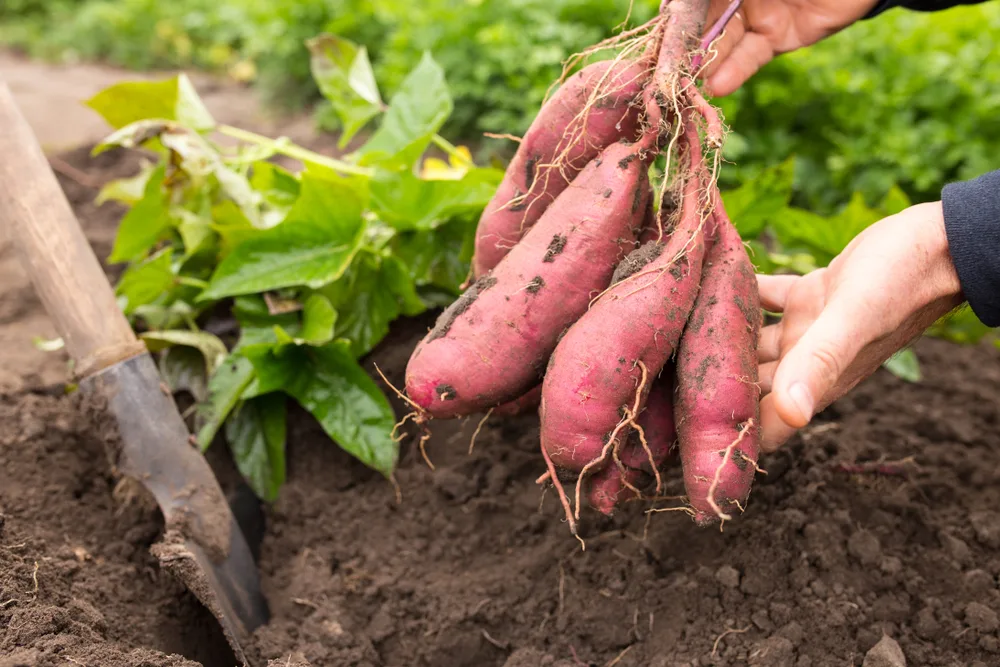
Sweet potatoes (Ipomoea batatas) are not only a versatile and nutritious root vegetable, known for their sweet taste and vibrant colors, but they’re also adaptable to various growing conditions, including different climates and soil types.
Mature sweet potato plants can tolerate drought, making them an excellent choice for areas with limited water availability.
With their ability to produce large harvests even from small planting spaces, it’s no surprise that sweet potatoes are a favorite among gardeners.
However, growing sweet potatoes at home isn’t without its challenges, such as dealing with pests, diseases, and root issues.
The Nutritional Powerhouse
Gardeners often choose to plant sweet potatoes because they’re packed with vitamins, minerals, and fiber, making them a highly nutritious addition to any diet.
These crops are relatively low-maintenance once they’re established, requiring minimal care.
However, to successfully grow sweet potatoes, it’s important to be aware of potential problems that might arise in your garden.
By taking proactive steps, you can reduce or even avoid the stress associated with growing sweet potatoes.
Common Challenges in Growing Sweet Potatoes
While sweet potatoes are generally easy to grow, they can face a number of challenges. One of the most common issues is pest infestations.
Sweet potatoes are vulnerable to pests like sweet potato weevils, aphids, whiteflies, wireworms, root-knot nematodes, and white grubs, all of which can damage the roots and reduce your yield.
To keep these pests at bay, consider rotating your crops, maintaining good garden hygiene, using row covers, and applying organic insecticides like diatomaceous earth when necessary.
Fungal diseases like Fusarium wilt, root rot, and black scurf, as well as viral infections such as sweet potato virus disease (SPVD) and bacterial diseases like black rot, can also affect sweet potatoes.
While these issues might seem daunting, there are ways to prevent them.
Plant certified disease-resistant varieties, practice good garden sanitation, rotate your crops regularly, test and amend the soil as needed, and avoid overwatering.
Sweet potatoes thrive in well-drained, sandy loam soil with a slightly acidic pH (ideally between 5.8 and 6.0).
Heavy clay soils can hinder root development, leading to stunted growth or stringy roots. To improve soil drainage, incorporate organic matter and avoid planting in compacted soils.
Caring for and Maintaining Sweet Potatoes
To ensure a successful sweet potato harvest, follow these care and maintenance tips. Start sweet potato slips indoors 4-6 weeks before the last frost date, or purchase them from a trusted nursery.
Plant the slips in loose, well-drained loamy soil once all danger of frost has passed. Sweet potatoes prefer full sun to partial shade and need consistent moisture, especially during the growing season.
Water them deeply once or twice a week, reducing the frequency as the plants mature, and make sure the soil stays evenly moist but not waterlogged.
Avoid over-fertilizing, as too much nitrogen can lead to lush foliage at the expense of root development. Use a balanced fertilizer or compost to supply essential nutrients before planting and throughout the growing season.
Harvest your sweet potatoes when the foliage starts to yellow and die back, typically about four to five months after planting, depending on the variety.
Carefully dig up the tubers, taking care not to damage them, and cure them in a warm, humid environment for 10-14 days before storing.
By addressing potential challenges and following these tips, you can grow sweet potatoes with confidence and enjoy abundant harvests of these delicious, nutritious tubers from your garden.
